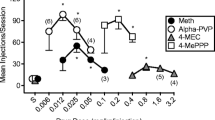Abstract
After initial exposure to 80 mg/kg, pigeons trained on a two-key drug discrimination procedure rapidly learned to discriminate 120 mg/kg ethosuximide from saline. When 40–160 mg/kg doses of ethosuximide were administered during generalization tests, the percentage of responses directed to the ethosuximide-appropriate key varied directly with dose. Time-effect determinations revealed that the discriminable properties of ethosuximide were evident as early as 15 min after, and as late as 2 h after, intramuscular injection. The discriminative stimulus properties of ethosuximide failed to generalize to the anticonvulsant compounds clonazepam (0.5–4 mg/kg), methsuximide (25–200 mg/kg), and phenytoin (5–15 mg/kg). Generalization was apparent with certain doses of primidone (250, 300 mg/kg) and mephenytoin (80, 160, 240 mg/kg). The concomitant administration of pentylenetetrazol (5, 10, 20 mg/kg) partially blocked the discriminable properties of the training dose of ethosuximide.
Similar content being viewed by others
References
Brown PL, Jenkins HM (1968) Auto-shaping of the pigeon's keypeck. J Exp Anal Behav 11:1–8
Brown TR, Dreifuss FE, Dyken PR, Goode DJ, Penry JK, Porter RJ, White PT, White BG (1975). Ethosuximide in the treatment of absence (petit mal) epilepsy. Neurology 25:515–525
Dreifuss FE (1982) Ethosuximide: Toxicity. In: Woodbury DM, Penry JK, Pippenger CE (eds) Antiepileptic drugs. Raven, New York pp 647–654
Ferrendelli JA, Klunk WE (1982) Ethosuximide: Mechanisms of action. In: Woodbury DM, Penry JK, Pippenger CE (eds) Antiepileptic drugs. Raven, New York pp 655–662
Guey J, Charles C, Coquery C, Roger J, Soulayrol R (1967). Study of psychological effects of ethosuximide (Zarontin) on 25 children suffering from petit mal epilepsy. Epilepsia 8:129–141
Herling S, Valentino RJ, Winger GD (1980) Discriminative stimulus effects of pentobarbital in pigoens. Psychopharmacology 75:321–323
Krafft K, Cleary J, Poling A (1983) Discriminative stimulus properties of phenytoin in the pigeon. Psychopharmacology 79:82–83
Overton DA (1974) Experimental methods for the study of state-dependent learning. Fedn Proc Am Soc Exp Biol 33:1800–1813
Picker M, Poling A (1984) Effects of anticonvulsants on learning: Performance of pigeons under a repeated acquisition procedure when exposed to phenobarbital, clonazepam, valproic acid, ethosuximide, and phenytoin. J Pharmacol Exp Ther 230:127–135
Picker M, Wallace S, Hancock S, Poling A (1985a) Discriminative stimulus properties of valproic acid in the pigeon. Psychopharmacology 87:449–453
Picker M, White W, Poling A (1985b) Effects of phenobarbital, clonazepam, valproic acid, ethosuximide, and phenytoin on the delayed-matching-to-sample performance of pigeons. Psychopharmacology 86:494–498
Poling A, Picker M (1987) Behavioral effects of anticonvulsant drugs. In: Thompson T, Dews PB, Barrett J (eds) Advances in behavioral pharmacology, vol 5. Jama Press, Greenwich, CT (in press)
Poling A, Picker M, Grossett D, Vande Polder D (1985) Effects of valproic acid and ethosuximide on the responding of pigeons maintained under a multiple fixed-ratio fixed-interval schedule of food delivery. Pharmacol Biochem Behav 23:469–472
Rall TW, Schleifer LS (1985) Drugs effective in the therapy of epilepsies. In: Gilman AG, Goodman LS, Gilman AG (eds) The pharmacological basis of therapeutics. MacMillan, New York, pp 446–472
Smith LW, Phillipus MJ, Guard HL (1968) Psychometric study of children with learning problems and 14–6 positive spike EEG patterns, treated with ethosuximide (Zarontin) and placebo. Arch Dis Child 43:616–619
Soulayrol R, Roger J (1970) Adverse psychiatric effects of antiepilepsy drugs. Rev Neuropsychiatr Infant 18:591
Author information
Authors and Affiliations
Rights and permissions
About this article
Cite this article
Clark, R.D., Schlinger, H. & Poling, A. Discriminative stimulus properties of ethosuximide in the pigeon. Psychopharmacology 93, 466–469 (1987). https://doi.org/10.1007/BF00207236
Received:
Revised:
Issue Date:
DOI: https://doi.org/10.1007/BF00207236




